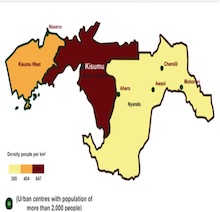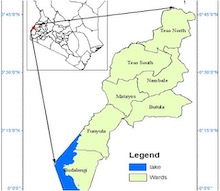About this CARP Project
Climate change is a global phenomenon that has resulted in significant health challenges facing humanity. Floods and droughts are the extreme weather events ravaging Sub-Saharan Africa, leading to multiple and complex challenges to an already hard-hit continent, Kenya is not an exception, as it has had its fair share of disasters resulting from these climate shocks. This climate variability affects disease vectors by; transmission dynamics, geographic spread, and re-emergence through multiple pathways, including; direct effects on the pathogen, the vector, non-human hosts, or humans hence increasing the vulnerability, especially of children to vector-borne diseases which continue to contribute significant global disease burden. According to WHO, about one-sixth of the illnesses and disabilities suffered globally are associated with vector-borne diseases, with more than half of the population at risk, among them, malaria is the major killer, followed by dengue virus. Health facilities are becoming increasingly burdened by the upsurge in health services demand due to climate change, facilities therefore ought to be prepared and adaptable to this variability. However, fewer studies have illustrated how health facilities are prepared, resilient, and adaptable to these emerging vector-borne diseases in Kenya. This study intends to determine health facility preparedness, risk factors, and health outcomes of the emerging climate-sensitive malaria and dengue virus among children below 5 years in Busia and Kisumu County, western Kenya, to help in developing policies that will be strategic in planning and health financing based on the disease burden and opportunities to enhance healthcare resilient in the phase of climate change in the region.
Main Research Questions
-
What is the health facility preparedness towards the emerging climate-sensitive malaria and dengue virus among children below 5 years in Kisumu and Busia Counties, Western Kenya?
-
What are the risk factors associated with the emerging climate-sensitive malaria and dengue virus among children below 5 years in Kisumu and Busia Counties, Western Kenya?
-
What are the proportions and health outcomes of the emerging sensitive malaria and dengue virus among children below 5 years in Kisumu and Busia Counties, Western Kenya?
-
What is the health economic burden associated with emerging climate-sensitive malaria and dengue virus among children below 5 years in Kisumu and Busia Counties, Western Kenya?
This project acknowledges that healthcare facilities should be the first defense in cases of climate change-related disasters, the vulnerability of people to vector-borne diseases is increased as the transmission dynamics, geographic spread, and re-emergence of these diseases are affected through multiple pathways, including direct effects on the pathogen, the vector, non-human hosts and humans, this bulging demand of healthcare services can only be met when the health facility are adaptable to such climatic variability. This research intends to inform national and county governments in Kenya about the burden and risk factors associated with the emerging climate-sensitive malaria and dengue virus therefore providing an opportunity to enhance the preparedness of health facilities in times of climate change-related disasters like malaria and dengue outbreaks.
Study site: Level 2, 3, and 4 public health facilities in Busia and Kisumu Counties in Western Kenya
 Kisumu County is one of 47 counties in the Republic of Kenya. Its headquarters is Kisumu City which is the third largest city in Kenya after the capital Nairobi and the coastal city of Mombasa. It has a population of 1,155,574 (2019 National Census).
Kisumu County is one of 47 counties in the Republic of Kenya. Its headquarters is Kisumu City which is the third largest city in Kenya after the capital Nairobi and the coastal city of Mombasa. It has a population of 1,155,574 (2019 National Census).
The county has seven Sub-Counties, Kisumu East, Kisumu Central, Kisumu West, Muhoroni, Nyakach, Nyando, and Seme. The study will be done in Kisumu Central sub-county.
Map of study sites -Kisumu Central Sub-County, Kisumu
 Busia is a county in the former Western Province of Kenya. It borders Kakamega County to the east, Bungoma County to the north, Lake Victoria and Siaya County to the south, and Busia District, Uganda to the west. The county has about 893,861 people and spans about 1,700 square kilometers making it one of the smallest counties in Kenya. Busia is inhabited mainly by the Luhya tribe of Kenya.
Busia is a county in the former Western Province of Kenya. It borders Kakamega County to the east, Bungoma County to the north, Lake Victoria and Siaya County to the south, and Busia District, Uganda to the west. The county has about 893,861 people and spans about 1,700 square kilometers making it one of the smallest counties in Kenya. Busia is inhabited mainly by the Luhya tribe of Kenya.
The sub-counties include; Butula, Funyula, Budalang’i, Nambale, Matayos, Teso North, and Teso South. The study will be done in Budalang’i.
Map of study site – Budalang’i Sub-County, Busia

Jack Ogony
Junior Faculty & PhD Student
Early-Career Investigator
Study Principal investigator
ogonyjack@gmail.com

Dr. Judith Mangeni
Senior Lecturer | Department of Epidemiology & Biostatistics,
School of Public Health at Moi University, Kenya
Study Co-investigator and contact person
nakholi2001@yahoo.com

Prof. Simon Karanja
Medical Epidemiology & Head of Digital Health Applied Research Centre (DHARC)
Jomo Kenyatta University of Agriculture and Technology (JKUAT), Kenya
Study Investigator

Dr. Diana Menya
Senior Lecturer
Department of Epidemiology & Medical Statistics,
School of Public Health | Moi University, Kenya
Study Co-investigator

Prof. George Ayodo

